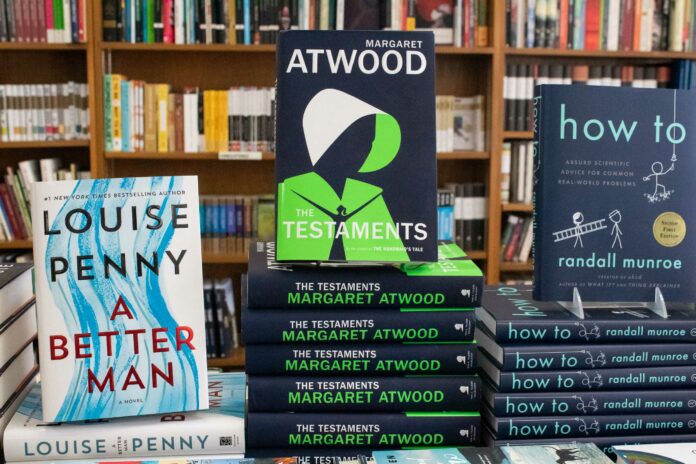Atwood’s sequel to “The Handmaid’s Tale” comes at the right time for readers
Margret Atwood’s “The Handmaid’s Tale,” published in 1985, has become a cultural sensation in recent years due to Atwood’s dystopian Gilead resonating with today’s political climate. Under the Trump administration, images of the red-clad and veiled handmaid began popping up at rallies and protests — a symbol of what the world was becoming for women everywhere.
A large part of this resurgence was also due to the premier of the Hulu original television series “The Handmaid’s Tale,” which aired in 2016. It received critical acclaim and 14 Primetime Emmy awards. The show follows June (Offred), played by Elizabeth Moss. While the first season follows the original novel closely, later seasons have developed beyond the plot Atwood created.
Unsurprisingly, Atwood decided that there was more of this world worth exploring. On Sept. 10, she published a sequel to “The Handmaid’s Tale,” set 15 years after her first novel ends. Titled “The Testaments,” Atwood details the late-stages of Gilead’s rule, as well as those working within the system to destroy it. The story is told through manuscripts and witness testimonies of the narrators who are attempting to shed light on Gilead’s corruption.
“The Testaments” is told from the perspective of three female narrators: the infamous Aunt Lydia from the original novel, a young woman growing up in Gilead named Agnes and a Canadian student named Daisy. While the novel’s time period jumps over the events that take place in the Hulu series, there is a significant connection between the series and what Atwood includes in the novel.
The novel answers questions that fans everywhere have had about Gilead and the characters who live in it while also developing new plots.
The New York Times describes the novel as a “riveting and deeply satisfying escapist fantasy” for the new age. It details the derailment of a society that is no longer as fictional and far-fetched as it was in the original “Handmaid’s Tale.”
One of Atwood’s greatest strengths as a writer is her ability to create deeply complex and interesting female characters.
This is expertly proven with the character of Aunt Lydia. As an “Aunt” of Gilead, Lydia is in charge of training and controlling the Handmaids. They are allowed to read and write, and therefore hold much more power than most women in Gilead.
The original novel and Hulu series depicts Aunt Lydia as a cold and rigid matron, blinded by the rules of the world and the power she has over the Handmaids.
“The Testament’s,” however, adds many layers to the character. Through her testimonies, it’s revealed that Lydia has been plotting the downfall of Gilead for some time. She tells the story of how she was abducted by the Eyes (the law enforcement in Gilead) and put through a series of grueling tests to determine her usefulness as an authority figure in their society. Everything she does has been for survival — or so she claims in her testimony.
In an interview with Time, Atwood discusses Aunt Lydia’s leading role and her unreliable narration. Whether or not Aunt Lydia is a good person is up entirely to the perspective of the reader, Atwood said.
“Let Aunt Lydia speak for herself, and make up your own mind,” Atwood said.
The other two narrators become involved in Aunt Lydia’s plot to take down Gilead, but their characters felt much less developed than Lydia’s. The novel’s only true criticism has been over Atwood’s struggle to narrate the voice of younger women.
“At the root of this may be that Atwood remains an unsentimental writer,” an article for NPR states. “Shattering horror visits these two, yet somehow, it’s never wrenching to read.”
Without giving too much away, however, the identity of these characters hold enough importance that readers will find themselves invested in their stories anyway. Atwood is an expert at creating page-turners and “The Testaments” keeps readers interested.
The novel is already wildly successful — selling out and being groomed for awards. The world Atwood had created back in 1985 needed to be revisited, and “The Testaments” does so with satisfying results.
“The Handmaid’s Tale” was a warning, similar to Geroge Orwell’s “1984,” of a world that Atwood feared. Years later, post-”Me Too” and with continuous rollbacks of protections by the current Presidential administration, “The Testaments” is a reaction to the actualization of many of her fears, and a hopeful message that bravery and truth will ultimately prevail.
Written By: Alyssa Ilsley — arts@theaggie.org





I think everything posted made a great deal of sense. However, what about this?
suppose you typed a catchier title? I ain’t saying your content is not solid,
but what if you added something that makes people desire more?
I mean Review: Margaret Atwood’s “The Testaments” – The Aggie is a little vanilla.
You could glance at Yahoo’s front page and watch how they write
post titles to get viewers to open the links.
You might add a video or a related pic or two to get people interested about everything’ve got to say.
Just my opinion, it might bring your posts a little bit more interesting.